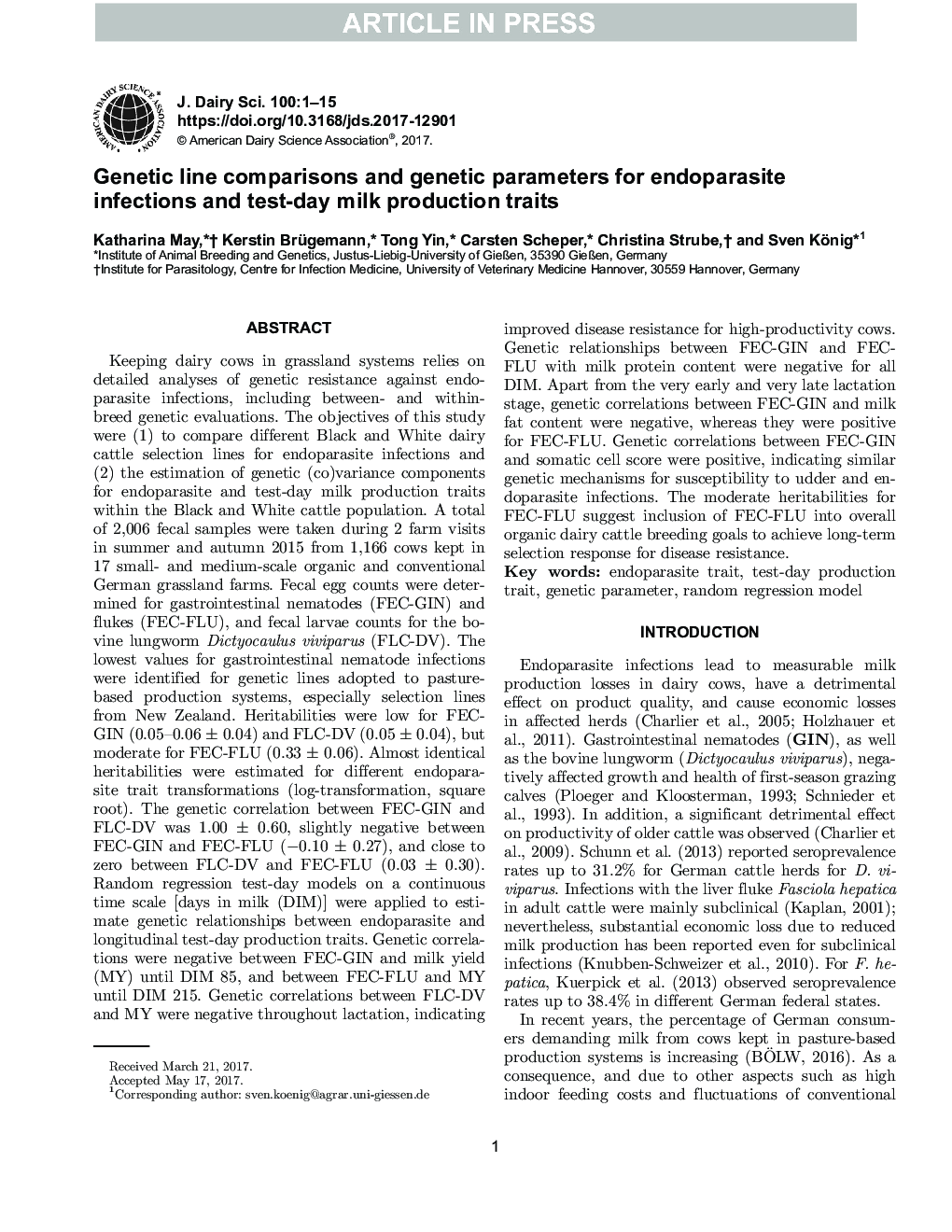| کد مقاله | کد نشریه | سال انتشار | مقاله انگلیسی | نسخه تمام متن |
|---|---|---|---|---|
| 5542093 | 1402514 | 2017 | 15 صفحه PDF | دانلود رایگان |
عنوان انگلیسی مقاله ISI
Genetic line comparisons and genetic parameters for endoparasite infections and test-day milk production traits
ترجمه فارسی عنوان
مقایسه صفات ژنتیکی و پارامترهای ژنتیکی عفونت های اندوپاراسیت و صفات تولید شیر روز آزمون
دانلود مقاله + سفارش ترجمه
دانلود مقاله ISI انگلیسی
رایگان برای ایرانیان
کلمات کلیدی
صفات اندوپاراسیت، صفات تولید روز تست، پارامتر ژنتیکی، مدل رگرسیون تصادفی
موضوعات مرتبط
علوم زیستی و بیوفناوری
علوم کشاورزی و بیولوژیک
علوم دامی و جانورشناسی
چکیده انگلیسی
Keeping dairy cows in grassland systems relies on detailed analyses of genetic resistance against endoparasite infections, including between- and within-breed genetic evaluations. The objectives of this study were (1) to compare different Black and White dairy cattle selection lines for endoparasite infections and (2) the estimation of genetic (co)variance components for endoparasite and test-day milk production traits within the Black and White cattle population. A total of 2,006 fecal samples were taken during 2 farm visits in summer and autumn 2015 from 1,166 cows kept in 17 small- and medium-scale organic and conventional German grassland farms. Fecal egg counts were determined for gastrointestinal nematodes (FEC-GIN) and flukes (FEC-FLU), and fecal larvae counts for the bovine lungworm Dictyocaulus viviparus (FLC-DV). The lowest values for gastrointestinal nematode infections were identified for genetic lines adopted to pasture-based production systems, especially selection lines from New Zealand. Heritabilities were low for FEC-GIN (0.05-0.06 ± 0.04) and FLC-DV (0.05 ± 0.04), but moderate for FEC-FLU (0.33 ± 0.06). Almost identical heritabilities were estimated for different endoparasite trait transformations (log-transformation, square root). The genetic correlation between FEC-GIN and FLC-DV was 1.00 ± 0.60, slightly negative between FEC-GIN and FEC-FLU (â0.10 ± 0.27), and close to zero between FLC-DV and FEC-FLU (0.03 ± 0.30). Random regression test-day models on a continuous time scale [days in milk (DIM)] were applied to estimate genetic relationships between endoparasite and longitudinal test-day production traits. Genetic correlations were negative between FEC-GIN and milk yield (MY) until DIM 85, and between FEC-FLU and MY until DIM 215. Genetic correlations between FLC-DV and MY were negative throughout lactation, indicating improved disease resistance for high-productivity cows. Genetic relationships between FEC-GIN and FEC-FLU with milk protein content were negative for all DIM. Apart from the very early and very late lactation stage, genetic correlations between FEC-GIN and milk fat content were negative, whereas they were positive for FEC-FLU. Genetic correlations between FEC-GIN and somatic cell score were positive, indicating similar genetic mechanisms for susceptibility to udder and endoparasite infections. The moderate heritabilities for FEC-FLU suggest inclusion of FEC-FLU into overall organic dairy cattle breeding goals to achieve long-term selection response for disease resistance.
ناشر
Database: Elsevier - ScienceDirect (ساینس دایرکت)
Journal: Journal of Dairy Science - Volume 100, Issue 9, September 2017, Pages 7330-7344
Journal: Journal of Dairy Science - Volume 100, Issue 9, September 2017, Pages 7330-7344
نویسندگان
Katharina May, Kerstin Brügemann, Tong Yin, Carsten Scheper, Christina Strube, Sven König,
